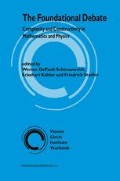Abstract
In this paper I want to show among other things one unexpected connection between the usage of infinitely small quantities and the analytical hierarchy of sets. The usage of infinitely small quantities is due to Leibniz but I use the modern version of the usage by working in a theory similar to the Nelson’s Internal set theory1. The theory is a weaker one than Nelson’s theory and I think that it contains the minimum for reasonable work with infinitely small quantities. Hence the results can be applied for a large amount of structures and in my opinion it is more similar to the original usage of infinitesimals than e.g. Nelson’s theory just mentioned. A part of the technique which I use was developed in alternative set theory2 and hence I mention also some ideas concerning this theory. This is also, in my opinion, in accordance with the main themes of the conference. Using our theory we find an exact, even algorithmical connection of the notions defined with the help of the infinitely small quantities and the corresponding notions definable in the Cantor’s set theory. This theory deals with the actual infinity and it is used as a basis for modern mathematics. In spite of the algorithmical method of exact translations, the translations of the notions defined with the help of infinitely small quantities are comprehensible only in the case of the classical analytical notions such as the limit, continuity, limit point etc. For the more complicated notions (some of them will be specified later) we obtain by known algorithms only incomprehensible notions and I give an argument why this situation takes place. It is interesting that in the translation algorithm introduced by me the complexity of the nonstandard definition has its counterpart in the complexity of the standard translation. The complexity concept mentioned concerns the analytical hierarchy of sets and this is the connection I want to talk about.
Access this chapter
Tax calculation will be finalised at checkout
Purchases are for personal use only
Preview
Unable to display preview. Download preview PDF.
Notes
Edward Nelson, “Internal set theory: A new approach to nonstandard analysis”, in BAMS 83, 1977, pp. 1165–1198.
Petr Vopénka, Mathematics in the Alternative set Theory. Leipzig: Teubner Verlagsgesellschaft 1979 )
Petr Vopénka, “The Philosophical Foundations of Alternative Set Theory”, in Int. J. General Systems Vol. 20, 1991, pp. 115–126.
Petr Vopénka, “The Philosophical Foundations of Alternative Set Theory”, loc.cit., p.1
Antonin Sochor, “The Alternative Set Theory and Arithmetic”, in: Seminarber., Humboldt-Univ. Berlin, Sekt. Math. 86, 1986.
E.g. Nelson’s Internal set theory, Edward Nelson, “Internal set theory: A new approach to nonstandard analysis”, Ibid., p.l.
Examples have been found by Keisler and Sochor; see W.A.J. Luxemburg: “A general theory of monads”, in W.A.J. Luxemburg (Ed), Applications of Model Theory to Algebra, Analysis, and Probability. New York: Holt, Rinehart and Winston. Inc. 1969, pp. 18–86, Antonin Sochor: “Differential calculus in the alternative set theory”, in Set Theory and Hierarchy Theory V, Lecture notes in mathematics 619, Berlin: Springer-Verlag 1977, pp. 273–284.
See Edward Nelson, “Internal set theory: A new approach to nonstandard analysis”, Ibid., p.1; Edward Nelson, “The syntax of nonstandard analyis”, in Annals of Pure and Applied Logic, Vol 38, 1988, pp. 123–134.; Karel Ada, “Translations of nonstandard definitions to standard ones”, in Comm. Math. Univ. Carolinae (Prague), Vol 25, 1984, pp. 615–634 ).
See Karel Lida, “Translations of nonstandardly defined notions”, in: From the logical point of view, 1, 1993, pp. 1–15.
For more details and the proof see Karel Cuda, “Translations of nonstandardly defined notions”, loc.cit p.4.
See Chen Chung Chang, H. Jerome Keisler, Model Theory, Studies in Logic 73. Amsterdam: North-Holland Publ. Comp. 1973.
This property is used in topology in alternative set theory; see Petr Vopénka, Mathematics in the Alternative set Theory., loc.cit., p.1.
For more details concerning this generalization see Karel Cuda, “Translations of nonstandard definitions to standard ones”, loc.cit., p.3.
Editor information
Editors and Affiliations
Rights and permissions
Copyright information
© 1995 Springer Science+Business Media Dordrecht
About this chapter
Cite this chapter
Čuda, K. (1995). A Connection between Leibniz’ Infinitely Small Quantities and the Analytical Hierarchy. In: Depauli-Schimanovich, W., Köhler, E., Stadler, F. (eds) The Foundational Debate. Vienna Circle Institute Yearbook [1995], vol 3. Springer, Dordrecht. https://doi.org/10.1007/978-94-017-3327-4_16
Download citation
DOI: https://doi.org/10.1007/978-94-017-3327-4_16
Publisher Name: Springer, Dordrecht
Print ISBN: 978-90-481-4617-8
Online ISBN: 978-94-017-3327-4
eBook Packages: Springer Book Archive

